Earl or Count?!
Some people named "Earl Cain" as "Count Cain". However, I think "Earl Cain" is more appropriated as Cain is a British.
What's
the difference between "Earl" and "Count"?
![]() The word "count"
itself bears more than one meanings. However, if we treat "Count"
as a title, then the meanings of "Earl" and "Count" are
the same : they are both a high rank in the nobleman hierarchy. The only difference
lies on "country boundary". Earl is for British nobleman whereas
Count is for other European nobles such as France, Italian, etc.
The word "count"
itself bears more than one meanings. However, if we treat "Count"
as a title, then the meanings of "Earl" and "Count" are
the same : they are both a high rank in the nobleman hierarchy. The only difference
lies on "country boundary". Earl is for British nobleman whereas
Count is for other European nobles such as France, Italian, etc.
![]()
THE
"PEERAGE" - the British Noble Hierarchy:
(from the highest ; the blanket means females' title):
Duke (Duchess) ![]()
Marquis (Marchioness)
Count (Countess)
Viscount (Viscountess)
Baron (Baroness)
![]() Through
Europe, heraldy is ubiquitous in the architecture and decoration of domestic
and ecclesiatical buildings, in illuminated manuscripts and official documents,
and on seals, monuments and memorials. Heraldic devices were a means of declaiming
feudal authority, and knightly pre-eminence. They were outward and visible
symbols of a man's position and influence, and of his household's status in
society.
Through
Europe, heraldy is ubiquitous in the architecture and decoration of domestic
and ecclesiatical buildings, in illuminated manuscripts and official documents,
and on seals, monuments and memorials. Heraldic devices were a means of declaiming
feudal authority, and knightly pre-eminence. They were outward and visible
symbols of a man's position and influence, and of his household's status in
society.
The term "peerage" includes the British degree of duke (the senior rank of the British peerage. Derived from the Latin dux, meaning 'leader', the rank was introduced into England in 1337) , marquess(belongs to the second rank) earl (the third rank. The earliest known charter creating an hereditary earl is that of c. 1140 by which King Stephen created Geoffrey de Mandeville Earl of Essex) , viscount (the fourth rank, the first creation being of 1440,though the title itself is considerably older) and baron (the fifth rank; the origin was uncertain). All of these hierarchy are hereditary. Derived from the medieval Latin paragium, it means simply 'a company of equals' and was originally applied to those of similar rank within the nobility. Each hierarchy has its associated Coronets & Coronation Robes as follows:
|
CORONETS
& CORONATION ROBES
|
||
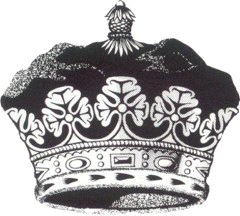 |
Duke
Silver-glit coronet of eight strawberry leaves (three and two lalves visile) with crimson velvet cap. Mantle has four rows of ermine on the cape. |
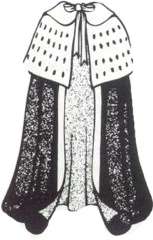 |
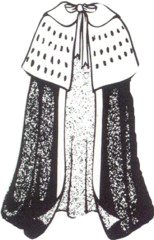 |
Marquess Coronet of silver gilt with four strawberry leaves (one and two halves visible) and four silver balls (two visible). Mantle has three rows and a half of erime on the cape. |
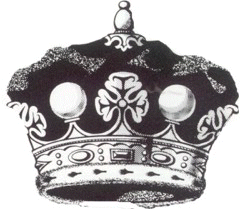 |
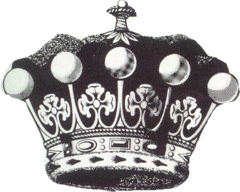 |
Earl
Can you imagine how Cain looks like when he wears these.... But, I guess he doesn't give a damn for wearing it?! |
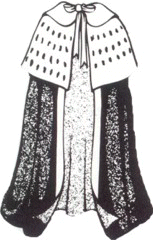 |
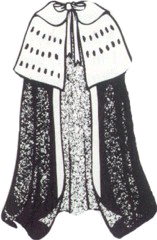 |
Viscount Silver-gilt cornet with sixteen silver balls (nine visible). Mantle has a cape with two rows and a half of ermine. |
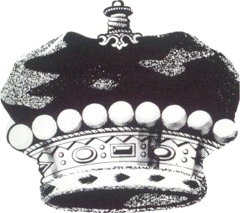 |
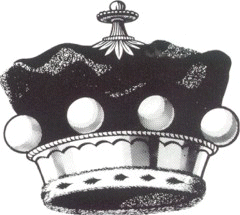 |
Baron
A plain silver-gilt circlet set with six silver balls (four visible). Mantle has two rows of ermine on the cape. |
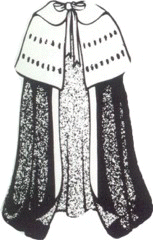 |
|
N.B. it seems that the above 5 robes look alike. If you look carefully, however, you can see the differences among each other. In a peer's letters patent of creation, the ceremorial insignia include 'a Cap of Honour' worn with a 'Coronet of Gold' on occassions of state. These coronets of rank are the lineal descendants of the combined medieval chapeau and gold circlet which, in the 14th century, were restricted to dukes and marquesses and, after 1444 , also to earls, though at that time they do not appear to have conformed to any particular pattern. Coronets were first granted to vsicounts by James I and to barons by Charles II in 1661. |
||
![]() Well,
well, well, we are now in the 21st century and I think noble ranking is a
rare and outdated product of a few people. After all, mankind should born
equal - even reality beats >_< ... Or, at least, citizens shouldn't
feed the nobleman by taxes, anyway . . .
Well,
well, well, we are now in the 21st century and I think noble ranking is a
rare and outdated product of a few people. After all, mankind should born
equal - even reality beats >_< ... Or, at least, citizens shouldn't
feed the nobleman by taxes, anyway . . .